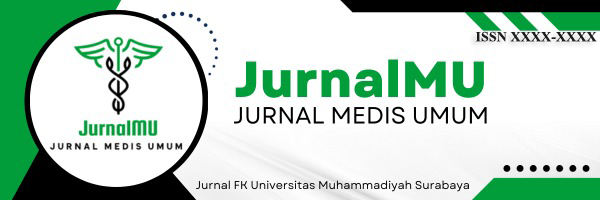Miopia Tinggi pada Kehamilan : Case Report
DOI:
https://doi.org/10.30651/jmu.v2i1.25643Kata Kunci:
Myopia, Pregnancy, High Myopia in Pregnancy, Retinal DetachmentAbstrak
Background: High Myopia (HM), defined as a myopic refractive error of ≥6 diopters
(D) or an axial length (AL) greater than 26.5 mm, is associated with various typical
pathological changes, such as fundus tessellation, conus, macular lesions, as well as
peripheral retinal and choroidal lesions. The choroid and retina are thought to be
vulnerable to the effects of pregnancy. HM is associated with retinal changes, and
patients with HM have a high risk of experiencing retinal detachment. Objective : This
case report aims to describe high myopia in pregnancy. Case Presentation : A 23-year-
old woman, GIP00000, at 37 weeks of gestation, came to the emergency department of
Dr. Soegiri Lamongan General Hospital with complaints of intense abdominal tightness
and swollen, painful feet. Her vision appeared blurred. High blood pressure was noted
in the third trimester. An obstetric examination showed that the fetal head had not
entered the pelvic inlet. Clinical symptoms included blurred vision, with visual acuity
results of VOD -8.00 D and VOS -8.00 D. Conclusion : High myopia in pregnancy is
a rare case. Diagnosis is based on patient history, clinical symptoms, and supportive
examinations. High myopia is not a contraindication for normal delivery. However,
high myopia poses a significant risk during pregnancy, which was considered as a basis
for a cesarean section to reduce risks in our case.
Keywords : Myopia, pregnancy, High Myopia in Pregnancy, retinal detachment.
Referensi
Dian Lestari Hidayah et al. (2023) “Mode of Delivery in the Second Pregnancy of
Mother With High Myopia and History of Sectio Cesarean: a Case Report,” Indonesian
Midwifery and Health Sciences Journal, 7(2), pp. 164–172. doi:
20473/imhsj.v7i2.2023.164-172.
Dinn RB, Harris A, Marcus PS. Ocular changes in pregnancy. Obstet Gynecol Surv.
;58(2):137-44.
Fernández-Montero, A. et al. (2017) “Effect of pregnancy in myopia progression: The
SUN cohort,” Eye (Basingstoke), 31(7), pp. 1085–1092. doi: 10.1038/eye.2017.24.
Gabriele ML, Wollstein G, Ishikawa H. Et a1. Optical coherence tomography: history,
current status, and laboratory work. Invest Ophthalmol Vis Sci. 2011;52(5):2425–36.
Gotovac M, Kastelan S, Lukenda A. Eye and pregnancy. Coll Antropol.
;37(1):189-93.
Holden BA, Fricke TR, Wilson DA, et al. Global prevalence of myopia and high
myopia and temporal trends from 2000 through 2050. Ophthalmol. 2016;123(5):1036–
Iskandar, F. et al. (2020) “Kontroversi Persalinan Spontan pada Miopia Tinggi,”
Cermin Dunia Kedokteran, 47(12), p. 779. doi: 10.55175/cdk.v47i12.1248.
Kubicka-Trzaska A, Karska-Basta I, Kobylarz J, et al. Pregnancy and the eye. Klin Ocz.
;110(10):401–4
Mackensen F, Paulus WE, Max R, et al. Ocular changes during pregnancy. Dtsch
Arztebl Int. 2014;111(33–34):567–75
Mackensen F, Paulus WE, Max R, Ness T. Ocular changes during pregnancy. Dtsch
Arzteblatt Int. 2014; 111(33–34):567–75.
Parver LM, Auker C, Carpenter DO. Choroidal blood flow as a heat dissipating
mechanism in the macula. Am J Ophthalmol. 1980;89(5):641–6.
Samra KA. The eye and visual system in pregnancy, what to expect? An in-depth
review. Oman J. Ophthalmol. 2013;6(2):87-91.
Sheth B, Mieler W. Ocular complications of pregnancy. Curr Opin Ophthalmol.
;12(6):455–63.
Yenerel NM, Küçümen RB. Pregnancy and the eye. TJO. 2015;45(5):213-9.



